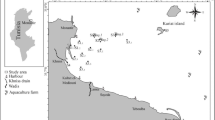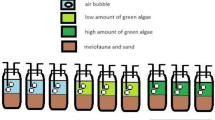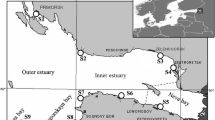Abstract
The environmental impact of a well-established fish farm has beeninvestigated in surface sediments of the Ligurian Sea in order to assess thebiodeposition, bacterial community structure and dynamics at a mature stage oforganic enrichment.The Biopolymeric carbon (BPC) fraction of organic matter and phytopigmentconcentrations displayed very high values beneath the fish cages. In particularlipid, carbohydrate and chlorophyll-a concentrations werehigher in farm sediment while protein concentrations did not show significantchange between farm sediment and control.Benthic bacteria were closely related to organic enrichment and their densitywas three times higher (up to 3 × 1010 cellsg−1) in stations beneath the cages being positivelycorrelated with BPC (n = 10, p < 0.05) and lipid (n = 10, p < 0.05)concentrations. Colony forming units (CFU) counts of heterotrophic bacteriaindicate a shift in the relative importance of the gram negative bacterialfraction, displaying the predominance of theCytophaga/Flexibacter-like bacteria (CBF), as well as theoccurrence of pathogenic bacteria (such as Vibrio) insediments beneath the farm. In contrast, Gram positive bacteria were moreprevalent in control site where they represented up to 90% of total isolates.Aminopeptidase activity displayed higher values in sediment beneath the cages,whereas the enzymatic activity per bacterial cell was lower. These data suggesta functional stress of bacterial degradation rates and represent a potentialvaluable environmental index of imbalance between supply and removal of organicmatter in eutrophicated environments.Data presented in this study also suggest that either the biochemicalcomposition of sedimentary organic matter as well as the selected microbialvariables may represent useful tools for evaluating the effects of organicenrichment due to fish farming and could be proposed as new environmentalindices of aquaculture impact on marine sediment.
Similar content being viewed by others
References
Albertelli G., Covazzi-Harriague A., Danovaro R., Fabiano M., Fraschetti S. and Pusceddu A. 1999. Bacteria-Meiofauna. Macrofauna interrelationships in an estuarine area (Ligurian Sea, NW Mediterranean): role of food availability. J. Sea Res. 42: 11–26.
Austin B. and Austin D.A. 1987. Bacterial Fish Pathogens: Disease in Farmed and Wild Fish. Halsted Press, New York, 364 pp.
Balebona M.C., Andreu M.J., Bordas M.A., Zorrilla I., Moriñigo M.A. and Borrego J.J. 1998. Pathogenicity of Vibrio alginolyticus for cultured gilt-head sea bream (Sparus aurata L.). Appl. Environ. Microbiol. 64: 4269–4275.
Bianchi A. and Giuliano L. 1996. Enumeration of viable bacteria in the marine pelagic environment. Appl. Environ. Microbiol. 62: 174–177.
Bjørklund H., Bondesteam J. and Bylund G. 1990. Residues of oxytetracycline in wild fish and sediments from fish farm. Aquaculture 86: 359–367.
Bligh E.G. and Dyer W.J. 1956. A rapid method for total lipid extraction and purification. Can. J. Biochem. Physiol. 37: 911–917.
Christensen K.D. and Horsted J. 1991. Miljøbelastning fra havbrug og salttvandsdambrug. DHF-rapport 397., Charlottenlund, p. 90.
Cottrell M.T. and Kirchman D.L. 2000. Natural assemblages of marine Proteobacteria and members of the Cytophaga-Flavobacter cluster consuming low-and high-molecular-weight dissolved organic matter. Appl. Environ. Microbiol. 66: 1692–1697.
Danovaro R. 2000. Benthic microbial loop and meiofaunal response to oil induced disturbance in coastal sediments: a review. Int. J. Environ. Poll. (in press).
Danovaro R., Dinet A., Duineveld G. and Tselepides A. 1999. Benthic response to particulate fluxes in different trophic environments: a comparison between the Gulf of Lions-Catalan Sea (W-Mediterranean) and Cretan Sea (E-Mediterranean). Prog. Oceanogr. 44: 287–312.
DeLong E.F., Wu K.Y., Prèzelin B.B. and Jovine R.V.M. 1994. High abundance of Archaea in Antartic marine picoplankton. Nature 371: 695–697.
Deming J.W. and Baross J.A. 1993. The early diagenesis of organic matter: bacterial activity. In: Engel M.H. and Macko S. (eds), Topics in Geobiology. Plenum Press, New York, pp. 119–144.
Dubois M., Gilles K., Hamilton J.K., Rebers P.A. and Smith F. 1956. Colorimetric method for determination of sugars and related substances. Analyt. Chem. 28: 350–356.
Fabiano M., Misic C., Manini E., Danovaro R., Povero P. and Chiatti S. 2001. Distribution and biochemical composition of suspended and sedimentary organic matter in the Northern Adriatic. In: Faranda F.M., Guglielmo L. and Spezie G. (eds), Structure and Processes in the Mediterranean Ecosystems. Vol. 57. Springer Verlag, pp. 447–454.
Fenchel T., Bernard C., Esteban G., Finlay B.J., Hansen P.J. and Iversen N. 1995. Microbial diversity and activity in a Danish fjord with anoxic deep water. Ophelia 43: 45–100.
Fenchel G.M., King G.M. and Blackburn T.H. 1998. Bacterial Biogeochemistry: The Ecophysiology of Mineral Cycling. 2nd edn. Academic Press, London, p. 307.
Findlay R.H., Watling L. and Mayer L.M. 1995. Environmental impact of salmon net-pen culture on marine benthic communities in Maine: a case study. Estuaries 18: 145–179.
Fry J.C. 1990. Direct methods and biomass estimation. In: Methods in Microbiology. Vol. 22. Academic Press, pp. 41–85 Methods in Microbiology. Vol. 22. Academic Press.
Gray J.P. and Herwig R.P. 1996. Phylogenetic analysis of the bacterial communities in marine sediments. Appl. Environ. Microbiol. 62: 4049–4059.
Hansen L.S. and Blackburn T.H. 1992. Effect of algal bloom deposition on sediment respiration and fluxes. Mar. Biol. 112: 147–152.
Hargrave B.T., Duplisea D.E., Pfeiffer E. and Wildish D.J. 1993. Seasonal changes in benthic fluxes of dissolved oxygen and ammonium associated with marine cultured Atlantic salmon. Mar. Ecol. Progr. Ser. 96: 249–257.
Hargrave B.T., Philip D.E., Doucette L.I., White M.J., Milligan T.J., Wildish T.J. et al. 1997. Assessing benthic impacts of organic enrichment from marine aquaculture. Water Air Soil Poll. 99: 641–650.
Hartree E.F. 1972. Determination of proteins: a modification of the Lowry methods that give a linear photometric response. Analyt. Biochem. 48: 422–427.
Henderson R.J., Forrest D.A.M., Black K.D. and Park M.T. 1997. The lipid composition of sea loch sediments underlying salmon cages. Aquaculture 158: 69–83.
Hjeltnes B. and Roberts R.J. 1994. Vibriosis. In: Inglis V., Roberts R.J. and Bromage N.R. (eds), Bacterial Diseases of Fish. Blackwell Science, Cambridge, pp. 109–121.
Hobbie J.E., Daley R.J. and Jasper S. 1977. Use of Nuclepore filters for counting bacteria by fluorescence microscopy. Appl. Environ. Microbiol. 33: 1225–1228.
Holmer M. 1991. Impacts of aquaculture on surrounding sediments: generation of organic-rich sediments. In: Pauw N. and Joyc J. (eds), Aquaculture and the Environment. Aquaculture Society Special Publication, 16. Vol. 16., pp. 155–175.
Holmer M. and Kristensen E. 1992. Impact of marine fish cage farming on metabolism and sulphate reduction of under-lying sediments. Mar. Ecol. Progr. Ser. 80: 191–201.
Holmes B. 1991. The genera Flavobacterium, Sphingobacterium, and Weeksella. In: Balows A., Truper H.G., Dworkin M., Harder W. and Schleifer K.H. (eds), The prokaryotes. Springer-Verlag, Berlin, Germany, pp. 3620–3630.
Hoppe H.G. 1993. Significance of exoenzymatic activities in the ecology of brackish water: measurements by means of methylumberlliferyl-substrate. Mar. Ecol. Progr. Ser. 80: 191–201.
Hugenholtz P., Goebel B.M. and Pace N.R. 1998. Impact of culture independent studies on the emerging phylogenetic view of bacterial diversity. J. Bacteriol. 180: 4765–4777.
Jensen M.H., Lomstein E. and Sörensen J. 1990. Benthic NH4+ and NO3- flux following sedimentation of a spring phytoplankton bloom in Aarhus bight, Denmark. Mar. Ecol. Progr. Ser. 61: 87–96.
Johnsen R.I., Grahl-Nielsen O. and Lunestad B.T. 1993. Environmental distribution of organic waste from a marine fish farm. Aquaculture 118: 229–244.
Karakassis I., Tsapakis M. and Hatziyanni E. 1998. Seasonal variability in sediment profiles beneath fish farm cages in the Mediterranean. Mar. Ecol. Progr. Ser. 162: 243–252.
Kay J.J. and Schneider E. 1995. Order from disorder: the thermodynamics of complexity in biology. In: Murphy M.P. and O'Neill L.A.J. (eds), What is life: the next fifty years. Reflections on the future of biology. Cambridge University Press, pp. 161–172.
Koop K. and Griffith C.I. 1982. The relative significance of bacteria meio and macrofauna on an exposed sandy beach. Mar. Biol. 66: 295–300.
La Rosa T. 1998. Comunità microbiche in aree interessate da impianti di maricoltura. PhD Dissertation, University of Messina, Italy.
La Rosa T., Mirto S., Mazzola A. and Danovaro R. 2001. Differential responses of benthic microbes and meiofauna to fish-farm disturbance in coastal sediments. Environ. Poll. 112: 427–434.
Lebaron P., Servais P., Troussellier M., Courties C., Muyzer G., Bernard L. et al. 2001. Microbial community dynamics in Mediterranean nutrient-enriched seawater mesocosms: changes in abundances, activity and composition. FEMS Microbiol. Ecol. 34: 255–266.
Llobet-Brossa E., Rossello-Mora R. and Amann R. 1998. Microbial community composition of Wadden Sea sediments as revealed by fluorescence in situ hybridisation. Appl. Environ. Microbiol. 64: 2691–2696.
Lorenzen C.J. and Jeffrey S.W. 1980. Determination of chlorophyll and phaeopigments spectrophotometric equations. Limnol. Oceanogr. 12: 343–346.
Marsh J.B. and Weinstein D.B. 1966. Simple charring method for determination of lipids. J. Lipid Res. 7: 574–576.
Mazzola A., Mirto S. and Danovaro R. 1999. Initial fish-farm impact on meiofaunal assemblages in coastal sediments of the Western Mediterranean. Mar. Poll. Bull. 38: 1126–1133.
Meyer-Reil L.A. 1987. Measurement of hydrolytic activity and incorporation of dissolved organic substrates by microorganism in marine sediments. Mar. Ecol. Progr. Ser. 31: 143–149.
Mirto S., La Rosa T., Danovaro R. and Mazzola A. 2000. Microbial and meiofaunal response to intensive Mussel-Farm Biodeposition in coastal sediment of the western Mediterranean. Mar. Poll. Bull. 40: 244–252.
Novitsky J.A. 1990. Evidence for sedimenting particles as the origin of the microbial community in coastal marine sediment. Mar. Ecol. Prog. Ser. 60: 161–167.
Pernthaler J., Sattler B., Simek K., Schwarzenbacher A. and Psenner R. 1996. Top-down effects on the size biomass distribution of a freshwater bacterioplankton community. Aquat. Microb. Ecol. 10: 255–263.
Poremba K. 1995. Hydrolytic enzymatic activity in deep-sea sediments. FEMS Microb. Ecol. 16: 213–222.
Posch T., Simek K., Vrba J., Pernthaler J., Nedoma J., Sattler B. et al. 1999. Predator-induced changes of bacterial size-structure and productivity studied on a experimental microbial community. Aquat. Microb. Ecol. 18: 235–246.
Pusceddu A., Sara G., Armeni M., Fabiano M. and Mazzola A. 1999. Seasonal and spatial changes in sediment organic matter composition of a semi-enclosed marine system (W-Mediterranean Sea). Hydrobiologia 397: 59–70.
Samuelsen O.B., Ervik A. and Solheim E. 1988. A qualitative and quantitative analyses of the sediment gas and diethylether exctract of the sediment from salmon farms. Aquaculture 74: 277–285.
Schäfer H., Bernard L., Courties C., Lebaron P., Servais P., Stackebrandt P.R.E. et al. 2001. Microbial community dynamics in Mediterranean nutrient-enriched seawater mesocosms: changes in the genetic diversity of bacterial populations. FEMS Microbiol. Ecol. 34: 243–25.
Smith P., Hiney M. and Samuelsen O. 1994. Bacterial resistance to antimicrobial agents used in fish farming: a critical evaluation of method and meaning. Annu. Rev. Fish Dis. 4: 273–313.
Torsvik V.L., Sorheim R. and Goksoyr J. 1988. Antibiotic resistance of bacteria from fish farm sediments. International Council for the Exploration of the Sea. Report No C.M. 1988/F:10.
Walton J.R. 1992. Use of antibiotics in veterinary practice. J. Med. Microbiol. 36: 69–70.
Waterbury J.B., Watson S.W., Valois F.W. and Franks D.G. 1986. Biological and ecological characterization of marine unicellular cyanobacterium Synechococcus. Can. Bull. Fish. Aquatic. Sci. 214: 71–120.
Weston D.P. 1990. Quantitative examination of macrobenthic community changes along an organic enrichment gradient. Mar. Ecol. Progr. Ser. 61: 233–244.
Wu R.S.S. 1995. The environmental impact of marine fish culture: towards a sustainable future. Mar. Poll. Bull. 31: 159–166.
Ye L.X., Ritz D.A., Fenton G.E. and Lewis M.E. 1991. Tracing the influence on sediment of solid waste from a salmonid farm using stable isotope analysis. J. Exp. Mar. Biol. Ecol. 145: 161–174.
Author information
Authors and Affiliations
Rights and permissions
About this article
Cite this article
Vezzulli, L., Chelossi, E., Riccardi, G. et al. Bacterial community structure and activity in fish farm sediments of the Ligurian sea (Western Mediterranean). Aquaculture International 10, 123–141 (2002). https://doi.org/10.1023/A:1021365829687
Issue Date:
DOI: https://doi.org/10.1023/A:1021365829687




